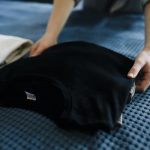Yes, pre-shrunk fabric can still shrink, but usually much less than regular fabric. Manufacturers treat it to reduce size changes, so you’ll likely notice only minimal shrinkage of about 1-3%. However, factors like washing methods and fabric type can still impact shrinkage. To keep your garments in shape longer, proper care is essential. Want to know how to maximize their longevity? There’s more to explore about the best practices for maintaining your wardrobe!
Table of Contents
Key Takeaways
- Pre-shrunk fabric is treated to minimize shrinkage but is not completely immune to it.
- Some residual shrinkage (1-3%) can still occur with pre-shrunk fabrics, especially in natural fibers.
- Washing methods, such as high heat or agitation, can induce additional shrinkage in pre-shrunk items.
- Care instructions, like washing in cold water and air drying, help maintain the size of pre-shrunk fabrics.
- Fabrics like cotton and linen are more prone to shrinkage compared to synthetic materials, even when pre-shrunk.
Understanding Pre-Shrunk Fabric
When you think about pre-shrunk fabric, it’s important to understand that this process aims to minimize the amount of shrinkage that occurs after the fabric is washed.
Basically, manufacturers treat the fabric before it reaches you, helping it retain its size and shape. This means that when you buy a garment made from pre-shrunk fabric, you’re less likely to experience unexpected alterations after washing.
It’s a great way to guarantee your clothing fits well over time. However, keep in mind that while pre-shrunk fabrics undergo treatment, they aren’t completely immune to shrinkage.
Factors like washing temperature and drying methods can still impact them, so it’s wise to follow care instructions to maintain your fabric’s integrity.
The Pre-Shrinking Process
To truly grasp how pre-shrunk fabric minimizes shrinkage, it helps to look at the pre-shrinking process itself.
Manufacturers typically expose the fabric to heat and moisture, simulating conditions it might face during washing. This step relaxes the fibers, allowing them to contract before the fabric is cut and sewn into garments.
Manufacturers use heat and moisture to relax fibers, ensuring fabric stability before garment construction.
After this treatment, the fabric’s fibers are stabilized, greatly reducing future shrinkage. Some methods even involve washing the fabric multiple times to guarantee it reaches its maximum shrinkage potential.
By the time you purchase a pre-shrunk item, it’s already undergone this rigorous process, making it less likely to shrink further when you wash it at home.
Understanding this process can help you make informed buying decisions.
Common Fabrics That Shrink
When it comes to fabric, not all materials behave the same way when washed.
Cotton, for instance, tends to shrink considerably, while bamboo and linen have their own unique characteristics.
On the other hand, synthetic fibers generally maintain their shape, making them a popular choice for those who want to avoid shrinkage issues.
Cotton Shrinkage Characteristics
Cotton is notorious for its tendency to shrink, especially when exposed to heat and moisture. When you wash your cotton items in hot water or dry them on high heat, you’re likely to notice some shrinkage. This is because cotton fibers contract when they absorb water and then dry.
Even pre-shrunk cotton can shrink slightly, usually around 3-5%, though it’s been treated to minimize this effect. To maintain the size of your cotton garments, wash them in cold water and tumble dry on low heat.
You might also want to air dry them to avoid any unwanted surprises. By taking these precautions, you can enjoy your cotton pieces longer without worrying about significant shrinkage.
Bamboo and Linen Behavior
While cotton is well-known for its shrinkage, other fabrics like bamboo and linen also have their quirks.
Bamboo fabric is often praised for its softness and breathability, but it can shrink if not cared for properly. When you wash bamboo, it’s essential to use cold water and a gentle cycle to minimize shrinkage.
Linen, on the other hand, is made from flax and has its own behavior. It can shrink considerably, especially if exposed to high heat during washing or drying.
To keep your linen items looking their best, always wash them in cold water and air dry when possible.
Synthetic Fiber Stability
Although synthetic fibers are generally more stable than natural ones, they can still shrink under certain conditions. Factors like heat and moisture can lead to unexpected changes in your fabric’s size. For instance, polyester and nylon may behave differently when exposed to high temperatures.
Here’s a quick overview of common synthetic fabrics and their potential for shrinkage:
| Fabric Type | Shrinkage Potential |
|---|---|
| Polyester | Low |
| Nylon | Moderate |
| Acrylic | High |
When washing or drying synthetic garments, always follow care instructions. Using appropriate temperatures can help maintain your fabric’s integrity and avoid unwanted shrinkage. Keep this in mind to enjoy your favorite clothes longer!
Factors Influencing Fabric Shrinkage
When you consider fabric shrinkage, several factors come into play that can significantly affect the outcome.
First, the type of fiber matters; natural fibers like cotton and wool are more prone to shrinkage than synthetic ones.
Next, the fabric’s weave and construction impact how it reacts to washing and drying. Higher thread counts often lead to less shrinkage.
Temperature also plays an important role; hot water and high heat during drying can exacerbate shrinkage.
Additionally, the care instructions you follow are essential; ignoring them can lead to unexpected results.
Finally, pre-washing methods used by manufacturers can influence how much shrinkage occurs, even in pre-shrunk fabrics.
Understanding these factors can help you manage shrinkage effectively.
Comparing Pre-Shrunk and Regular Fabric
When you compare pre-shrunk fabric to regular fabric, you’ll notice key differences in how they handle shrinkage.
Pre-shrunk fabric typically offers more stability and a better fit after washing, while regular fabric might surprise you with unexpected size changes.
Understanding these characteristics can help you choose the right material for your needs.
Shrinkage Characteristics Comparison
While you might think all fabrics behave the same way when it comes to shrinkage, there’s a notable difference between pre-shrunk and regular fabric. Pre-shrunk fabrics undergo a process that minimizes future shrinkage, making them a more reliable choice for your wardrobe. In contrast, regular fabrics can shrink considerably after washing, leading to unexpected size changes.
Here’s a quick comparison of shrinkage characteristics:
| Fabric Type | Shrinkage Potential |
|---|---|
| Pre-Shrunk | Minimal (1-3%) |
| Regular Fabric | Moderate (3-10%) |
| Cotton | Moderate (3-5%) |
| Polyester | Low (1-2%) |
| Blends | Variable (2-6%) |
Understanding these differences helps you make informed choices for your clothing needs.
Stability and Fit Differences
The differences in shrinkage characteristics between pre-shrunk and regular fabric directly impact their stability and fit.
Pre-shrunk fabrics undergo a treatment process that minimizes future shrinkage, helping garments retain their intended size. When you choose pre-shrunk fabric, you can expect a more consistent fit after washing, reducing the chances of disappointment when your clothes come out of the dryer.
In contrast, regular fabric may shrink considerably, altering the shape and fit of your clothing over time. This unpredictability can lead to a less reliable garment, especially if you’re looking for a tailored appearance.
Residual Shrinkage in Pre-Shrunk Fabrics
Although pre-shrunk fabrics are designed to minimize further shrinkage, it’s important to understand that some residual shrinkage can still occur. This is typically due to the fabric’s fiber composition and the way it’s treated during manufacturing.
Here’s a quick overview of factors affecting residual shrinkage:
| Factor | Impact on Shrinkage |
|---|---|
| Fiber Type | Natural fibers shrink more than synthetics. |
| Fabric Construction | Tighter weaves may reduce shrinkage risk. |
| Washing Conditions | Hot water or high heat can trigger shrinkage. |
| Drying Method | Air drying is gentler than machine drying. |
The Impact of Washing on Shrinkage
When you wash pre-shrunk fabrics, the conditions you choose can greatly influence their shrinkage potential. For instance, using hot water can relax the fibers more than cold water, leading to additional shrinkage.
Likewise, a high-heat dryer setting may cause the fabric to shrink further, even if it’s labeled as pre-shrunk. To minimize this risk, stick to cold or warm washes and use a low-heat setting when drying.
Also, avoid excessive agitation during washing, as it can stress the fibers and encourage shrinkage. Always check care labels for specific instructions, as different fabrics react differently.
Long-Term Care for Pre-Shrunk Garments
Maintaining the fit and quality of your pre-shrunk garments over time requires careful attention to their long-term care.
To keep your clothes looking great, follow these essential tips:
- Wash in Cold Water: This helps prevent any potential shrinkage and maintains fabric integrity.
- Avoid Harsh Detergents: Use gentle detergents to protect the fibers and color of your garments.
- Air Dry When Possible: Opt for air drying instead of using a dryer, which can cause wear and tear.
- Store Properly: Fold or hang your garments in a cool, dry place to avoid unnecessary stretching or fading.
Consumer Preferences for Fabric Types
Consumers today have a variety of fabric types to choose from, each offering unique benefits and challenges. When selecting fabrics, you might consider comfort, durability, and maintenance.
Cotton is popular for its softness and breathability, while polyester is favored for its wrinkle resistance and strength. If you’re eco-conscious, organic fabrics or sustainable materials could be your go-to options. You may also prefer blends, combining the best of both worlds.
For activewear, moisture-wicking fabrics can enhance performance, while linen offers a lightweight feel for warmer climates.
Ultimately, your choice depends on your lifestyle needs, personal style, and how much care you’re willing to invest in maintaining your garments. Keep these factors in mind to find the perfect fabric for you.
Frequently Asked Questions
Can Pre-Shrunk Fabrics Still Lose Shape Over Time?
Like a well-loved pair of jeans, pre-shrunk fabrics can lose shape over time. If you wash and wear them frequently, you’ll notice some stretching or distortion, so handle with care to maintain their original fit.
How Can I Tell if Fabric Is Pre-Shrunk?
You can usually tell if fabric’s pre-shrunk by checking the care label. Look for terms like “pre-shrunk” or “sanforized.” If it’s cotton, feel for a tighter weave, indicating it’s likely been treated.
Will Washing Temperatures Affect Pre-Shrunk Fabrics?
Washing temperatures can impact pre-shrunk fabrics. If you wash in hot water, you might still notice some minor shrinkage. Stick to cold or warm settings to maintain the fabric’s intended size and shape.
Are All Pre-Shrunk Fabrics Treated the Same Way?
You might think all pre-shrunk fabrics are the same, but they’re not. Manufacturers use different methods and treatments, so some may resist shrinkage better than others. Always check the labels for specifics!
Do Pre-Shrunk Fabrics Require Special Washing Instructions?
You don’t need special washing instructions for pre-shrunk fabrics, but it’s best to wash them in cold water and tumble dry on low. This helps maintain their shape and prolongs the fabric’s lifespan.
- Does Chiffon Fabric Stink - July 15, 2025
- Does Chiffon Fabric Affect the Economy - July 15, 2025
- Does Cotton Fabric Have a Nap - July 15, 2025







